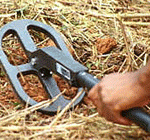Demining
MgM Menschen gegen Minen / People Against Landmines is an NGO working in the field of landmine detection and destruction. Their website provides a thorough insight into the subject, both on political implications and on practical demining methods and new technologies.
The existence of landmines in public spaces is one of the cruelest aftermaths of war: worldwide 100 million are spread in the grounds of former regions of war, causing the death or mutilation of more than an estimated 15.000 to 20.000 civilian victims every year. Mine-contaminated areas also form an obstacle to development, as they cannot be used for subsistence agriculture or for other economic activities, thus forcing people into reliance on external food aid programmes. Therefore, demining activities are not only a means of preventing unnecessary deadly accidents but also a process of fostering development.
The process of humanitarian and military demining should be differentiated: While military demining is focused on plainly providing opening up a path to gain ground in order to proceed, humanitarian demining demands the cleansing of an area by a 100%. Therefore, not only a different level of care but also completely different tools and methods are employed. Usually, different methods of mine detection are combined in order to achieve the desired result. The MgM team has sophisticated safety guidelines: deminers always work in teams of two, alternately working for 30 minutes while being observed by the other from a distance. First aid service and facilities for transportation to the hospital are on location.
The most common method of cleanup is the manual cleansing of a contaminated area:
First, the area is searched with a metal detector, which is very time-consuming, as pieces of rubbish etc. are also signaled. When an object is found, it is examined to determine if it is a landmine with a so-called prodder, a long poking stick with a needle. If the object is identified as a mine, it is carefully uncovered and marked for later destruction. Nolandmines provides a thorough overview on types of mines, basic excavation tools etc.
Usually, the bombs marked are detonated later, all at the same time by small charges of explosives placed next to the mines. Other methods of defuse include, burning, heterogeneous chemical reaction and autocatalytic decomposition, which are especially useful when the mines are close to spots of civil or infrastructural importance, like bridges.
Not all explosives are embodied in metal cases, more and more have plastic shells. Although, even these types of mines include tiny metal part. However, they are much more difficult and far less reliable to be identified by metal detectors. Therefore mine detection can be supported by the aid of sniffer dogs being trained to announce any smell of TNT in the air.
Apopo is an NGO training rats for mine detection. Rats are just as vapor sensitive as dogs are, they can be trained to solve tasks with rewards as incentive, they are more enduring than dogs, can browse through heavy vegetation and undergrowth and most importantly, are light enough to not detonate mines.
The Danish company Aresa has developed a biological method for TNT mine detection using genetically manipulated plants whose chlorophyll color changes with the appearance of TNT and UXO in the ground. To utilize this method, seeds could be thrown off a plane above a contaminated area, as the plants grow, demining workers will search for the colors changes in the plants to detect mines. Greenhouse testing has proved this to be a reliable method in the detection of mines, but no outdoor implementation has been performed thus far.
Machines for large scale demining activities have also been developed. MAXX Plus is a robot for clearing vegetation as a preparation step for manual demining, the robot is additionally equipped to transport mines found to the spot of detonation, and is constructed to withstand any explosion. Rotar MK2 is an excavator combined with a sieve barrel, digging up ground and sieving it through a grid, for easing the identification of landmines between the pieces of scrab.
The political debate about landmines has led to the Ottawa Convention, a ban on anti-personal-mines in 1997. This ban is controversial as it doesn’t ban anti-vehicle mines, which murder people just the same, and cluster bombs which are thrown off airplanes. Several initiatives lobby for the complete ban on all landmines and cluster bombs, their websites display thorough background information on the topic, eg Aktionsbündnis Landmine and International Campaign to Ban Landmines.
The sector of the United Nations that coordinates demining activities, victim assistance, mine-risk education, destruction of mine stockpiles and advocates against landmines is, the UN Mine Action Service.







